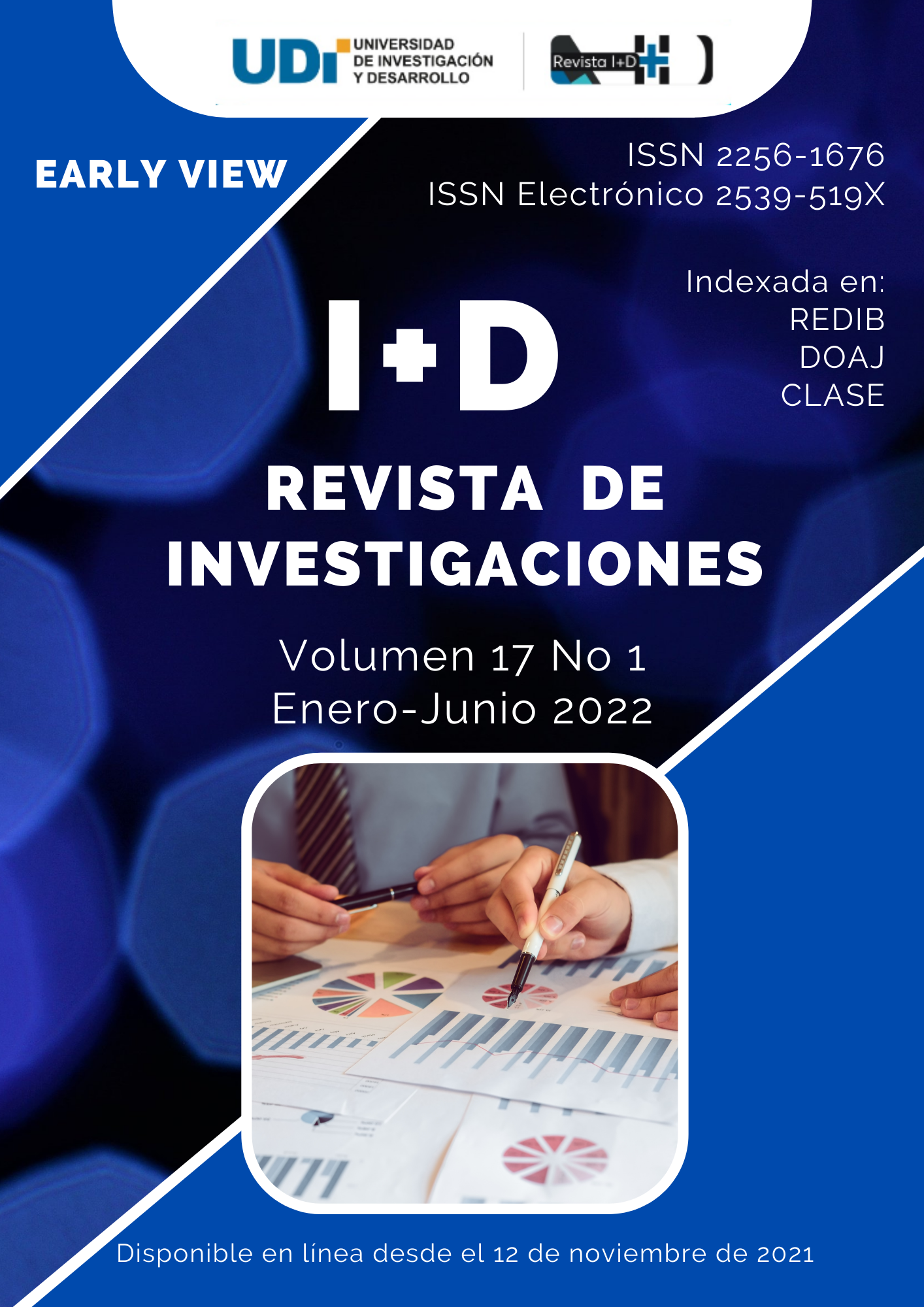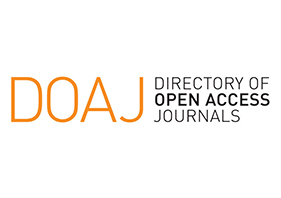Probability for bribe payment: multi-country approach for Latin America and the Caribbean
DOI:
https://doi.org/10.33304/revinv.v17n1-2022001Keywords:
Corruption, Americas, statistical probabilityAbstract
Bribery, as research issue, focuses on causality and impact analysis and in many cases has been subordinated as one of the many types of corruption. Using microdata from Transparency International's Global Corruption Barometer, the objective is to determine for a set of selected countries in Latin America and the Caribbean, the dependent variables to predict the probability of paying bribes when in contact with individuals, companies or entities that provide services. Inferential statistical techniques are used, such as logistic regression applying the maximum likelihood method and iterative process until the best model is found. From an initial survey with 117 variables, 11 variables were found to best explain the probability of paying a bribe. Variables such as level of schooling and the influence of officials and politicians affect people's willingness to pay a bribe. Significant topics of this study, such as retaliation to favor voting and sexual favors to receive benefits, although incipient in their study, are worth further research. This work can serve as a basis to motivate studies with microdata that help to better understand specific typologies of corruption through models that predict behaviors of ordinary citizens.Downloads
References
Ades, A., & Di Tella, R. (1999). Rents, competition, and corruption. American Economic Review, 89(4), 982–993. https://doi.org/10.1257/aer.89.4.982
Ali, A. M., & Isse, H. S. (2003). Determinants of Economic Corruption: A Cross-Country Comparison. Cato Journal, 22(3), 449–466. https://citeseerx.ist.psu.edu/viewdoc/download?doi=10.1.1.496.235&rep=rep1&type=pdf
Alt, J. E., & Lassen, D. D. (2003). The political economy of institutions and corruption in American States. Journal of Theoretical Politics, 15(3), 341–365. https://doi.org/10.1177/0951692803015003006
Andrès, A. R., & Ramlogan-Dobson, C. (2011). Is Corruption really bad for inequality? evidence from Latin America. The Journal of Development Studies, 47(7), 959–976. https://doi.org/10.1080/00220388.2010.509784
Azfar, O., Lee, Y., & Swamy, A. (2001). The Causes and Consequences of Corruption. The Annals of the American Academy of Political and Social Science, 573(1), 42–56. https://doi.org/10.1177/000271620157300103
Badawi, A., & AlQudah, A. (2014). The Impact of Anti-Corruption Policies on the Profitability and Growth of the Firms Listed in the Stock Market-Application on Singapore (Panel Data Analysis). SSRN Electronic Journal. https://doi.org/10.2139/ssrn.2952730
Banerjee, A., Mullainathan, S., & Hanna, R. (2012). CORRUPTION (National Bureau of Economic Research Working Paper 17968). https://www.nber.org/system/files/working_papers/w17968/w17968.pdf
Beets, S. D. (2005). Understanding the demand-side issues of international corruption. Journal of Business Ethics, 57, 65–81. https://doi.org/10.1007/s10551-004-3824-3
Berlanga-Silvente, V., & Vilà-Baños, R. (2014). Cómo obtener un Modelo de Regresión Logística Binaria con SPSS. Revista d’Innovació i Recerca En Educació REIRE, 7(2), 105–118. https://doi.org/10.1344/reire2014.7.2727
Bliss, C., & Di Tella, R. (1997). Does Competition Kill Corruption? Journal of Political Economy, 105(5), 1001–1023. https://doi.org/10.1086/262102
Brunetti, A., & Weder, B. (2003). A free press is bad news for corruption. Journal of Public Economics, 87(7–8), 1801–1824. https://doi.org/10.1016/S0047-2727(01)00186-4
Čábelková, I., & Hanousek, J. (1999). The Power of Negative Thinking: Corruption Perception and Willingness to Bribe in Ukraine. http://home.cerge-ei.cz/hanousek/power.pdf
Canache, D., & Allison, M. E. (2005). Perceptions of political corruption in Latin American democracies. Latin American Politics and Society, 47(3), 91–111. https://doi.org/10.1111/j.1548-2456.2005.tb00320.x
David-Barrett, E. (2014). Are some bribes more harmful than others? Exploring the ethics behind anti-bribery laws. Journal of Interdisciplinary Economics, 26(1–2), 119–144. https://doi.org/10.1177/0260107914540830
Davis, J. H., & Ruhe, J. A. (2003). Perceptions of Country Corruption: Antecedents and Outcomes. Journal of Business Ethics, 43, 275–288. https://doi.org/10.1023/A:1023038901080
Dobson, S., & Ramlogan-Dobson, C. (2012). Why is Corruption Less Harmful to Income Inequality in Latin America? World Development, 40(8), 1534–1545. https://doi.org/10.1016/j.worlddev.2012.04.015
Donchev, D., & Ujhelyi, G. (2014). What do corruption indices measure? Economics and Politics, 26(2), 309–331. https://doi.org/10.1111/ecpo.12037
Dong, B., Dulleck, U., & Torgler, B. (2012). Conditional corruption. Journal of Economic Psychology, 33(3), 609–627. https://doi.org/10.1016/j.joep.2011.12.001
Dong, B., & Torgler, B. (2009). Corruption and political interest: Empirical evidence at the micro level. Journal of Interdisciplinary Economics, 21(3), 295–325. https://doi.org/10.1177/02601079X09002100304
Eiras, A. (2003). The Poverty of Nations. In (Issue Brief No.ed091803b). The Heritage Foundation. https://www.heritage.org/global-politics/commentary/the-poverty-nations
Elbahnasawy, N. G., & Revier, C. F. (2012). The Determinants of Corruption: Cross-Country-Panel-Data Analysis. The Developing Economies, 50(4), 311–333. https://doi.org/10.1111/j.1746-1049.2012.00177.x
Fried, B. J., Lagunes, P., & Venkataramani, A. (2010). Corruption and Inequality at the Crossroad: A Multimethod Study of Bribery and Discrimination in Latin America on JSTOR. Latin American Research Review, 45(1), 76–97. https://www.jstor.org/stable/27919176
Gao, Y. (2011). Government Intervention, Perceived Benefit, and Bribery of Firms in Transitional China. Journal of Business Ethics, 104, 175–184. https://doi.org/10.1007/s10551-011-0896-8
Gatti, R., & Fisman, R. (2000). Decentralization and Corruption: Evidence across Countries (World Bank Policy Research Working Papers 2290). https://openknowledge.worldbank.org/handle/10986/19852
Getz, K. A., & Volkema, R. J. (2001). Culture, Perceived Corruption, and Economics: A Model of Predictors and Outcomes. Business & Society, 40(1), 7–30. https://doi.org/10.1177/000765030104000103
Gurgur, T., & Shah, A. (2005). Localization and Corruption: Panacea or Pandora’s Box? (World Bank Policy Research Working Paper 3486). https://documents1.worldbank.org/curated/en/945181468763526056/pdf/wps3486.pdf
Guvenli, T., & Sanyal, R. (2012). Perception and Understanding of Bribery in International Business. Ethics and Behavior, 22(5), 333–348. https://doi.org/10.1080/10508422.2012.706140
Heidenheimer, A. J. (1989). Perspectives on the Perception of Corruption. In Political Corruption: A Handbook (5 ed, p. 1017). Transaction Publishers. https://books.google.com.co/books?id=fGmCngEACAAJ&dq=Perspectives+on+the+Perception+of+Corruption+1989&hl=es&sa=X&redir_esc=y
Herzfeld, T., & Weiss, C. (2003). Corruption and legal (in)effectiveness: an empirical investigation. European Journal of Political Economy, 19, 621–632. https://doi.org/10.1016/S0176-2680(03)00018-1
Hunt, J., & Laszlo, S. (2012). Is Bribery Really Regressive? Bribery’s Costs, Benefits, and Mechanisms. World Development, 40(2), 355–372. https://doi.org/10.1016/j.worlddev.2011.06.001
Husted, B. W. (1999). Wealth, culture, and corruption. Journal of International Business Studies, 30(2), 359. https://doi.org/10.1057/palgrave.jibs.8490073
Iwasaki, I., & Suzuki, T. (2012). The determinants of corruption in transition economies. Economics Letters, 114(1), 54–60. https://doi.org/10.1016/j.econlet.2011.08.016
Jeong, Y., & Weiner, R. J. (2012). Who bribes? Evidence from the United Nations’ oil-for-food program. Strategic Management Journal, 33(12), 1363–1383. https://doi.org/10.1002/smj.1986
Kaufmann, D., Kraay, A., & Mastruzzi, M. (2007). Governance Matters VI: Governance Indicators for 1996-2006 (World Bank Policy Research Working Paper No. 4280). https://papers.ssrn.com/sol3/papers.cfm?abstract_id=999979
Klitgaard, R. (1998). International Cooperation Against Corruption. International Monetary Fund. Finance & Development, 35(1), 3–6. https://www.proquest.com/openview/ebba70a5ed8fabe0732c5146d32dba50/1?pq-origsite=gscholar&cbl=1819673
Knack, S., & Azfar, O. (2000). Are Larger Countries Really More Corrupt? (The World Bank policy research working paper 2470). https://openknowledge.worldbank.org/bitstream/handle/10986/19757/multi_page.pdf?sequence=1&isAllowed=y
La Porta, R., Lopez-de-Silanes, F., Shleifer, A., & Vishny, R. (1999). The quality of government. Journal of Law, Economics, and Organization, 15(1), 222–279. https://doi.org/10.1093/jleo/15.1.222
Lambsdorff, J., & Cornelius, P. (2000). Corruption, foreign investment and growth. In The Africa Competitiveness Report. https://www.researchgate.net/profile/Johann-Lambsdorff/publication/285889564_Corruption_foreign_investment_and_growth/links/5670054408ae4d9a42598917/Corruption-foreign-investment-and-growth.pdf
Lederman, D., Loayza, N. V., & Soares, R. R. (2005). Accountability and corruption: Political institutions matter. Economics and Politics, 17(1), 1–35. https://doi.org/10.1111/j.1468-0343.2005.00145.x
Lee, W. S., & Guven, C. (2013). Engaging in corruption: The influence of cultural values and contagion effects at the microlevel. Journal of Economic Psychology, 39, 287–300. https://doi.org/10.1016/j.joep.2013.09.006
Leite, C., & Weidmann, J. (1999). Does Mother Nature Corrupt? Natural Resources, Corruption, and Economic Growth (International Monetary Fund Working Paper 99/85). https://www.imf.org/external/pubs/ft/wp/1999/wp9985.pdf
Martin, K. D., Cullen, J. B., Johnson, J. L., & Parboteeah, K. P. (2007). Deciding to bribe: A cross-level analysis of firm and home country influences on bribery activity. Academy of Management Journal, 50(6), 1401–1422. https://doi.org/10.5465/AMJ.2007.28179462
Mauro, P. (1996). The Effects of Corruption on Growth, Investment, and Government Expenditure (International Monetary Fund Working Paper 96/98). https://papers.ssrn.com/sol3/papers.cfm?abstract_id=882994
McMillan, J., & Zoido, P. (2004). How to subvert democracy: Montesinos in Peru. Journal of Economic Perspectives, 18(4), 69–92. https://doi.org/10.1257/0895330042632690
Melgar, N., Rossi, M., & Smith, T. W. (2010). The perception of corruption in a cross-country perspective: Why are some individuals more perceptive than others? Economia Aplicada, 14(2), 183–198. https://doi.org/10.1590/S1413-80502010000200004
Mocan, N. (2004). What Determines Corruption? International Evidence from Micro Data (National Bureau of Economic Research Working Paper 10460). https://www.nber.org/system/files/working_papers/w10460/w10460.pdf
Mocan, N. (2008). What determines corruption? International evidence from microdata. Economic Inquiry, 46(4), 493–510. https://doi.org/10.1111/j.1465-7295.2007.00107.x
Moore Jr, E. C. (2007). Causes of Demand for International Bribery. Electronic Journal of Business Ethics and Organization Studies, 12(2), 18–23. https://jyx.jyu.fi/bitstream/handle/123456789/25398/1/ejbo_vol12_no2_pages_18-23.pdf
Myint, U. (2000). Corruption: Causes, Consequences and Cures. Asia-Pacific Development Journal, 7(2), 33–58.
Olken, B. A. (2009). Corruption perceptions vs. corruption reality. Journal of Public Economics, 93(7–8), 950–964. https://doi.org/10.1016/j.jpubeco.2009.03.001
Olken, B. A., & Pande, R. (2011). Corruption in Developing Countries (NBER. Abdul Latif Jameel Poverty Action Lab’s Governance Initiative; Working Paper 17398). https://doi.org/10.1146/annurev-economics-080511-110917
Olken, B. A., & Pande, R. (2012a). Corruption in developing countries. Annual Review of Economics, 4, 479–509. https://doi.org/10.1146/annurev-economics-080511-110917
Olken, B. A., & Pande, R. (2012b). Corruption in Developing Countries (Abdul Latif Jameel Poverty Action Lab’s Governance Initiative, which is funded by DFID, the Hewlett Foundation, and an anonymous donor). https://economics.mit.edu/files/7589
Park, H. (2003). Determinants of Corruption: A Cross-National Analysis. Multinational Business Review, 11(2), 29–48. https://doi.org/10.1108/1525383X200300010
Peiffer, C., & Rose, R. (2018). Why Are the Poor More Vulnerable to Bribery in Africa? The Institutional Effects of Services. The Journal of Development Studies, 54(1), 18–29. https://doi.org/10.1080/00220388.2016.1257121
Pellegrini, L. (2011). Causes of Corruption: A Survey of Cross-Country Analyses and Extended Results. In Corruption, Development and the Environment (pp. 29–51). Springer, Dordrecht. https://doi.org/10.1007/978-94-007-0599-9_3
Pring, C., & Vrushi, J. (2019). Barómetro Global de la Corrupción America Latina y el Caribe 2019. Opiniones y experiencias de los ciudadanos en materia de corrupción. https://www.transparency.org/files/content/pages/2019_GCB_LAC_Full_Report_ES.pdf
Ramamoorthy, N., Kulkarni, S. P., & Gupta, A. (2015). To Bribe or Not to Bribe? Determinants in the Indian Context. European Management Review, 12, 247–259. https://doi.org/10.1111/emre.12053
Reinikka, R., & Svensson, J. (2005). Fighting Corruption to Improve Schooling: Evidence from a Newspaper Campaign in Uganda. Journal of the European Economic Association, 3(2–3), 259–267. https://doi.org/10.1162/jeea.2005.3.2-3.259
Richards, L., & Heath, A. (2016). Explaining the incidence of bribery in Europe: a multilevel analysis (Working Paper 2016-1). http://csi.nuff.ox.ac.uk/wp-content/uploads/2016/04/2016-01-Explaining-the-incidence-of-bribery-in-Europe.pdf
Rose-Ackerman, S. (1997). Corruption and Development. Annual Bank Conference on Development Economics, 1–46. https://documents1.worldbank.org/curated/en/976271538245051917/pdf/Corruption-and-development.pdf
Rose-Ackerman, S., & Palifka, B. J. (2016). Corruption and Government: Causes, Consequences, and Reform (2 ed). Cambridge University Press. https://assets.cambridge.org/97811070/81208/frontmatter/9781107081208_frontmatter.pdf
Rose, R., & Mishler, W. (2010). Experience versus perception of corruption: Russia as a test case. Global Crime, 11(2), 145–163. https://doi.org/10.1080/17440571003669175
Rotondi, V., & Stanca, L. (2015). The effect of particularism on corruption: Theory and empirical evidence. Journal of Economic Psychology, 51, 219–235. https://doi.org/10.1016/j.joep.2015.09.008
Sanchez, J. I., Gomez, C., & Wated, G. (2008). A value-based framework for understanding managerial tolerance of bribery in Latin America. Journal of Business Ethics, 83(2), 341–352. https://doi.org/10.1007/s10551-007-9623-x
Sanyal, R. (2005). Determinants of bribery in international business: The cultural and economic factors. Journal of Business Ethics, 59, 139–145. https://doi.org/10.1007/s10551-005-3406-z
Sanyal, R. N., & Samanta, S. K. (2004). Determinants of bribery in international business. Thunderbird International Business Review, 46(2), 133–148. https://doi.org/10.1002/tie.20001
Serra, D. (2006). Empirical determinants of corruption: A sensitivity analysis. Public Choice, 126, 225–256. https://doi.org/10.1007/s11127-006-0286-4
Shahabuddin, S. (2002). The Causes and Consequences of Bribery in International Business. International Journal of Management, 19(2), 366–376. https://www.proquest.com/openview/6c5810ab6a99fa850ce3f7a2bbb62065/1?pq-origsite=gscholar&cbl=5703
Steward, G. W. (1987). Collinearity and Least Squares Regression . Statistical Science, 2(1), 68–84. https://www.jstor.org/stable/2245615
Svensson, J. (2005). Eight questions about corruption. Journal of Economic Perspectives, 19(3), 19–42. https://doi.org/10.1257/089533005774357860
Swamy, A., Knack, S., Lee, Y., & Azfar, O. (2001). Gender and corruption. Journal of Development Economics, 64(1), 25–55. https://doi.org/10.1016/S0304-3878(00)00123-1
Tanzi, V. (1998). Corruption Around the World: Causes, Consequences, Scope, and Cures (International Monetary Fund Working Paper 98/63). https://www.imf.org/external/pubs/ft/wp/wp9863.pdf
The Hungarian Gallup Institute HGI. (1999). Basic Methodological aspects of Corruption Measurement: Lessons learned from the literature and the pilot study. https://www.unodc.org/documents/treaties/corruption_hungary_rapid_assess.pdf
Tian, Q. (2008). Perception of business bribery in China: The impact of moral philosophy. Journal of Business Ethics, 80, 437–445. https://doi.org/10.1007/s10551-007-9429-x
Treisman, D. (2000). The causes of corruption: a cross-national study. Journal of Public Economics, 76(3), 399–457. https://doi.org/10.1016/S0047-2727(99)00092-4
Uslaner, E. (2015). The consequences of corruption. In Routledge Handbook of Political Corruption (1 ed, pp. 199–211). Routledge. https://www.routledge.com/Routledge-Handbook-of-Political-Corruption/Heywood/p/book/9781138594890
Van Rijckeghem, C., & Weder, B. (1997). Corruption and the Rate of Temptation: Do Low Wages in the Civil Service Cause Corruption? (International Monetary Fund Working Paper 97/73). https://www.imf.org/external/pubs/ft/wp/wp9773.pdf
Wei, S.-J. (2000). Bribery in the Economies: Grease or Sand? (pp. 1–33). The World Bank’s Development Research Group. https://www.brookings.edu/wp-content/uploads/2016/06/20000115.pdf
Weyland, K. G. (1998). The politics of corruption in Latin America. Journal of Democracy, 9(2), 108–121. https://doi.org/10.1353/jod.1998.0034
Wu, X. (2009). Determinants of Bribery in Asian Firms: Evidence from the World Business Environment Survey. Journal of Business Ethics, 87, 75–88. https://doi.org/10.1007/s10551-008-9871-4
You, J. S., & Khagram, S. (2005). A comparative study of inequality and corruption. American Sociological Review, 70(1), 136–157. https://doi.org/10.1177/000312240507000107
Zouaoui, A., Al Qudah, A., El Aoun, C., Ben Arab, M., & Eleuch, H. (2017). Impact of corruption on economic development: Case of Tunisia. The 3rd International Conference on Organization and Management ICOM, 12(2). https://doi.org/10.18576/amis/120221












